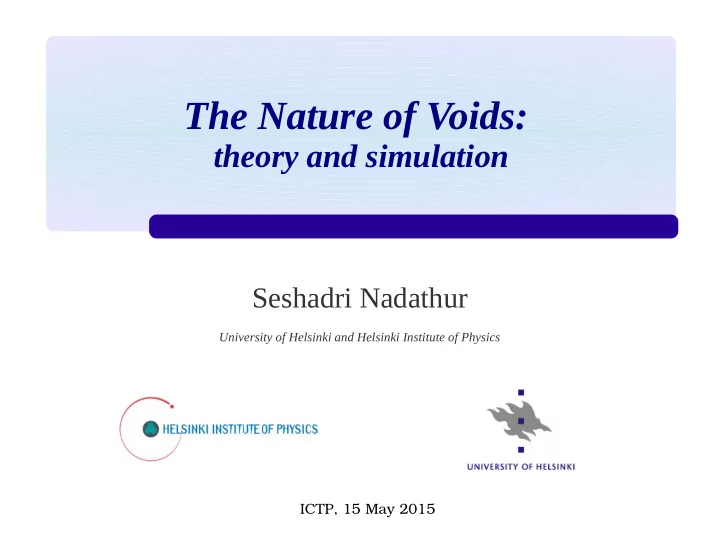

The Nature of Voids: theory and simulation Seshadri Nadathur University of Helsinki and Helsinki Institute of Physics ICTP, 15 May 2015
What can voids tell us?
Modifjed gravity? DE evolution? Li, Zhao & Koyama 2012 Clampitt, Cai & Li 2013 Lavaux & Wandelt 2012 Cai, Padilla & Li 2014 ... Bos et al. 2013 Hamaus et al. 2014 ... What can WDM? Bias? voids tell Yang et al. 2014 Chan, Hamaus & Desjacques 2014 us? Growth rate? Primordial NG? Kamionkowski et al. 2009 Falsify LCDM? D'Amico et al. 2011 ( a la most extreme clusters …) Coupled DE-DM? Chongchitnan 2015 Sutter et al. 2014
Abundances Sizes Correlations DM content What can we (indirectly, via observe lensing/ISW) Galaxy about voids? distribution within voids Shapes/alignments Environmental dependence
What is a 'void'? Theory Practice Sheth & van de Weygaert 2004 Need an algorithm to search for - excursion set formalism voids – many different - spherical evolution algorithms! - 'voids' defined by shell-crossing Observation Simulation - Visible galaxies - DM particles/halos/mock galaxies - survey boundaries + mask - cubic box, periodic BC - variable selection function - see everything in the box - light cone - multiple snapshots, ICs known practical algorithm that can handle both ZOBOV (Neyrinck 2008) but be careful in applying ZOBOV to survey data! (see Nadathur & Hotchkiss 2014)
What is a 'void'? Theory Practice Sheth & van de Weygaert 2004 Need an algorithm to search for ? - excursion set formalism voids – many different = - spherical evolution algorithms! - 'voids' defined by shell-crossing Observation Simulation - Visible galaxies - DM particles/halos/mock galaxies - survey boundaries + mask - cubic box, periodic BC - variable selection function - see everything in the box - light cone - multiple snapshots, ICs known practical algorithm that can handle both ZOBOV (Neyrinck 2008) but be careful in applying ZOBOV to survey data! (see Nadathur & Hotchkiss 2014)
ZOBOV uses Voronoi tessellation to reconstruct density Self-adaptive scaling – more resilient to shot noise
ZOBOV is a watershed algorithm figure from Mark Neyrinck
ZOBOV is a watershed algorithm figure from Mark Neyrinck
To identify voids, ZOBOV requires a set of tracers of the DM density field in a simulation DM particles as tracers – ok, but unobservable (we see galaxies) Strategy 2 Strategy 1 Use mock galaxies Use random subset of DM particles – HOD/SHAM/semi-analytic in simulation – match mock clustering properties – match to mean galaxy density to surveys in surveys Strategy 2 appears more realistic, but let's start with Strategy 1.
Theoretical model of voids: main features – Shell-crossing occurs when (for all voids) – Lin. extrapolated – Void distribution – Smaller voids deeper density minima
figure courtesy Elena Massara & Ravi Sheth
figure courtesy Elena Massara & Ravi Sheth
We already know void distribution in simulations doesn't fit well ... Nadathur & Hotchkiss 2015a So what about other features?
Larger voids are deeper – generic feature of ZOBOV (and all watershed void finders!)
'Universal' density profjle? Nadathur & Hotchkiss 2015a Hamaus, Sutter & Wandelt 2014 We don't agree. (But our result is consistent with watershed principles)
T racer number density vs. dark matter density Nadathur & Hotchkiss 2015a Related, but not the same. Larger voids still have deeper minima.
DM content of voids different radii same radius, diff. min. tracer densities Nadathur & Hotchkiss 2015a
The word 'void' means different things in different contexts! Excursion set model voids ≠ ZOBOV/watershed voids
What about voids traced by galaxies?
Galaxies change void abundances and sizes > 50% difference in total numbers! Nadathur & Hotchkiss 2015b, in prep.
Sub-sampled HOD mocks DM tracers Nadathur & Hotchkiss 2015b, in prep.
Galaxy voids trace DM underdensities difgerently
Voids traced by galaxies ≠ voids traced by sub-sampled DM (obvious, with hindsight?)
Compensation of mass defjcit in voids Nadathur & Hotchkiss 2015b, in prep.
Compensation of mass defjcit in voids Sub-sampled HOD mocks DM tracers Linear relationship, universal predictor of compensation Nadathur & Hotchkiss 2015b, in prep.
Gravitational potential in voids Naturally, Φ↔Δ Hotchkiss & Nadathur 2015, in prep.
Gravitational potential in voids Sub-sampled DM tracers HOD mocks Hotchkiss & Nadathur 2015, in prep.
Summary ● Excursion set model does not match (watershed) voids in simulation – because algorithms don't find objects matching model assumptions ● Meaning of the word 'void' context-dependent! ● Need for simulation-led approach/calibration ● In simulations, all void observables depend on tracer properties ● So to be observationally relevant, simulations must use mock galaxy tracers ● There are some nice properties of simulated voids – Δ, Φ – which can be predicted from observable quantities ● Maybe theory should start from here (work for the future...)
Recommend
More recommend